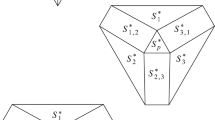Abstract
We deal with a robust notion of weak normals for a wide class of irregular curves defined in Euclidean spaces of high dimension. Concerning polygonal curves, the discrete normals are built up through a Gram–Schmidt procedure applied to consecutive oriented segments, and they naturally live in the projective space associated with the Gauss hyper-sphere. By using sequences of inscribed polygonals with infinitesimal modulus, a relaxed notion of total variation of the jth normal to a generic curve is then introduced. For smooth curves satisfying the Jordan system, in fact, our relaxed notion agrees with the length of the smooth jth normal. Correspondingly, a good notion of weak jth normal of irregular curves with finite relaxed energy is introduced, and it turns out to be the strong limit of any sequence of approximating polygonals. The length of our weak normal agrees with the corresponding relaxed energy, for which a related integral-geometric formula is also obtained. We then discuss a wider class of smooth curves for which the weak normal is strictly related to the classical one, outside the inflection points. Finally, starting from the first variation of the length of the weak jth normal, a natural notion of curvature measure is also analyzed.

Similar content being viewed by others
References
Alexandrov, A.D., Reshetnyak, Yu.G.: General Theory of Irregular Curves. Mathematics and Its Applications. Soviet Series. Kluwer, Dordrecht (1989)
Ambrosio, L., Fusco, N., Pallara, D.: Functions of Bounded Variation and Free Discontinuity Problems. Oxford University Press, Oxford (2000)
Banchoff, T.F.: Global geometry of polygons. III. Frenet frames and theorems of Jacobi and Milnor for space polygons. Rad Jugoslav. Akad. Znan. Umjet. 396, 101–108 (1982)
Cantarella, J., Fu, J.H.G., Kusner, R., Sullivan, J.M., Wrinkle, N.C.: Criticality for the Gehring link problem. Geom. Topol. 10, 2055–2116 (2006)
Fáry, I.: Sur la courbure totale d’une courbe gauche faisant un noeud. Bull. Soc. Math. France 77, 128–138 (1949)
Gluck, H.: Higher curvatures of curves in Euclidean space. Amer. Math. Monthly 73, 699–704 (1966)
Gutkin, E.: Curvatures, volumes and norms of derivatives for curves in Riemannian manifolds. J. Geom. Phys. 61, 2147–2161 (2011)
Jordan, C.: Sur la théorie des courbes dans l’espace à \(n\) dimensions. C. R. Acad. Sci. Paris 79, 795–797 (1874)
Milnor, J.W.: On the total curvature of knots. Ann. of Math. 52, 248–257 (1950)
Mucci, D., Saracco, A.: The weak Frenet frame of non-smooth curves with finite total curvature and absolute torsion. Ann. Mat. Pura Appl. 199, 2459–2488 (2020)
Penna, M.A.: Total torsion. Amer. Math. Monthly 87, 452–461 (1980)
Reshetnyak, Yu.G.: The theory of curves in differential geometry from the point of view of the theory of functions of a real variable. Russian Math. Surveys 60, 1165–1181 (2005)
Sullivan, J.M.: Curves of finite total curvature. In: Bobenko, A.I., Schröder, P., Sullivan, J.M., Ziegler, G. (eds.) Discrete Differential Geometry. Oberwolfach Seminars, vol. 38. Birkäuser, Boston (2008)
Acknowledgements
The research of D.M. was partially supported by the GNAMPA of INDAM. The research of A.S. was partially supported by the GNSAGA of INDAM.
Author information
Authors and Affiliations
Corresponding author
Ethics declarations
Conflict of interest
The authors declare that they have no conflict of interest.
Additional information
Publisher's Note
Springer Nature remains neutral with regard to jurisdictional claims in published maps and institutional affiliations.
Appendix: Proof of Proposition 3
Appendix: Proof of Proposition 3
Assuming \(N=3\), according to the notation from (4), the fifth-order expansions of \(\mathbf{c}\) at s give:
where \(\mathbf{a}\) and \(\mathbf{b}\) depend on \(\mathbf{c}^{(5)}(s)\). We thus get:
and
whence (5) holds. We also have
where
and hence
where
that gives
As a consequence, we get
whence
and definitely (6) holds, where
with the coefficient \(\varOmega \) of \(\mathbf{n}_1\) equal to
Moreover, in order to compute \(\mathbf{N}_2(h)\), we check:
and hence
Furthermore,
so that
where
We thus obtain:
where
Putting the terms together, we get:
where
and definitely (7) holds, where in terms of the orthonormal basis \((\mathbf{t},\mathbf{n}_1,\mathbf{n}_2,\mathbf{n}_3)\) we obtain formula (8) for \(\mathbf{D}\).
Finally, formula (9) follows by arguing as in the proof of Proposition 2. In fact, the Gram–Schmidt procedure yields that \((\mathbf{t}(h),\mathbf{n}_1(h),\mathbf{n}_2(h),\mathbf{n}_3(h))\) is an orthonormal basis of \({{\mathbb {R}}}^4\), whence \(\mathbf{n}_3(h)=\mathbf{n}_3+\mathbf{o}(1)\).
More precisely, we have \(\mathbf{n}_3(h)=\pm *(\mathbf{t}(h)\wedge \mathbf{n}_1(h)\wedge \mathbf{n}_2(h))\), where \(*\) is the Hodge operator in \({{\mathbb {R}}}^4\), whereas \(*(\mathbf{t}\wedge \mathbf{n}_1\wedge \mathbf{n}_2)=\pm \mathbf{n}_3\), with the same sign ± in the previous two formulas, by our choice in (4). Using that
for some real numbers \(\alpha ,\beta ,\gamma \in {{\mathbb {R}}}\), we get \(\mathbf{t}(h)\wedge \mathbf{n}_1(h)=\mathbf{t}\wedge \mathbf{n}_1+\alpha \,\mathbf{t}\wedge \mathbf{n}_2\,h+\mathbf{o}(1)\wedge \mathbf{o}(1)\,h\) and hence \(\mathbf{t}(h)\wedge \mathbf{n}_1(h)\wedge \mathbf{n}_2(h)=\mathbf{t}\wedge \mathbf{n}_1\wedge \mathbf{n}_2+\mathbf{o}(1)\wedge \mathbf{o}(1)\wedge \mathbf{o}(1)\,h\), whence actually (9) holds true, as required.
Rights and permissions
About this article
Cite this article
Mucci, D., Saracco, A. Weak curvatures of irregular curves in high-dimensional Euclidean spaces. Ann Glob Anal Geom 60, 181–216 (2021). https://doi.org/10.1007/s10455-021-09773-6
Received:
Accepted:
Published:
Issue Date:
DOI: https://doi.org/10.1007/s10455-021-09773-6




